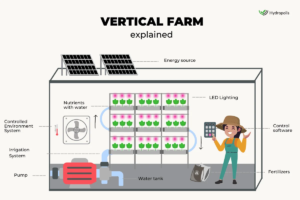Cultivating the Future with Vertical Farming
Written by: Chad Park
Traditional agriculture is being limited by finite resources such as water and land as it struggles to keep up with global food demand in a world marked by population growth. Furthermore, traditional agriculture is extremely harmful to the environment and is believed to be one of the leading causes of climate change. As these problems will only become exacerbated in the near future, finding a better way to farm is essential. In response to these issues, a new technique has emerged and is gaining popularity: vertical farming. Vertical farming is an important food production shift requiring new technology to produce crops in vertical indoor habitats.
What is Vertical Farming?
Vertical farming is the practice of cultivating vertical surfaces that are piled in layers. In contrast to traditional farming, where crops are grown in horizontal rows, vertical farming consists of growing crops above one another, resulting in more efficient farming. Vertical farming is thought to have originated in the Hanging Gardens of Babylon, which were erected by King Nebuchadnezzar II over 2,500 years ago. Humans have utilized similar strategies throughout history to improve farming efficiency, and in 1999, the concept of modern vertical farms emerged from a class at the University of Columbia. Vertical farming can mostly be found within indoor environments like buildings and warehouses, as the regulation of environmental conditions is essential for the plants’ growth.
Plants are grown in vertically stacked layers in optimally controlled environments, including LED lights that mimic sunlight to promote photosynthesis. Vertical farming also does not require soil; instead, it supplies the water straight to the plant’s roots, saving precious water. Many vertical farms also use automation to monitor and adjust environmental conditions, water, and nutrient levels.
Figure 1

Diagram of a Vertical Farm
Source: Hydropolis
What are the Pros and Cons of Vertical Farming?
The efficiency of vertical farming offers many benefits, especially considering its reduced consumption of water and space. More specifically, vertical farming uses 98 percent less water and 99 percent less land than traditional farming. Vertical farming also increases production significantly for several reasons. First, vertical farms are enclosed in controlled climate conditions, ensuring that crops grow to their full potential. Furthermore, cultivating indoors means that crops can be grown all year long. Vertical farming’s use of controlled environment agriculture (CEA) also eliminates many external factors that could potentially harm plants in traditional farming, including temperature and wildlife. Vertical farming also helps the environment in a variety of ways. First, it supports sustainable development by allowing farmers to grow crops all year round with maximum efficiency. Second, vertical farming reduces the water footprint by massively reducing water usage compared to traditional farming.
Vertical farming may not all be so versatile, however. Starting a vertical farm is extremely expensive: the setup cost is around $1000 per square meter. In addition to high initial costs, vertical farming requires specialized equipment, such as hydroponic systems and special LED lights. The costs of maintaining these technologies, including repairs, can be especially expensive. Lastly, there are only a limited number of crops that can be grown with vertical farming. For example, several staple foods like rice and wheat are still unprofitable when grown in vertical farms; therefore, most vertical farms, as of now, primarily grow crops such as lettuce and microgreens. However, as technology and farming techniques continue to evolve, the types of crops grown in vertical farming will continue to expand.
Conclusion:
While vertical farming is a promising alternative to sustainable food production, its high initial costs and limited crop viability require further refinement. However, with ongoing technical advancements and huge cost reductions, vertical farming has the potential to transform agriculture and contribute to a more secure and sustainable food future. While vertical farming has various advantages, including lower water and land usage, higher productivity, and environmental sustainability, it also faces obstacles such as high starting expenditures, limited crop diversity, and continuous maintenance costs. Nonetheless, continued advances in technology and farming practices promise to expand the range of crops suitable for vertical farming, paving the way for a more diverse and resilient agricultural environment in the future.
References and Sources:
Anna. (2023, October 30). How does a vertical farm work: Step by step guide: Blog hydropolis. Hydropolis. https://www.hydro-polis.com/en/how-does-a-vertical-farm-work-step-by-step-guide/#how_does_vertical_farming_work
Crumpacker, M. (2018, October 19). A look at the history of Vertical Farming. Medium. https://medium.com/@MarkCrumpacker/a-look-at-the-history-of-vertical-farming-f4338df5d0f4
Dupuis, A. (2023, January 19). Vertical farming: Everything you need to know. Eden Green. https://www.edengreen.com/blog-collection/what-is-vertical-farming#:~:text=for%20future%20generations.-,What%20is%20Vertical%20Farming%3F,land%20(or%20even%20less).
Farming, B. (2023, May 2). Vertical farming: Why growing up can make a difference. https://bowery.co/vertical-farming/
Understanding the pros and cons of vertical farming. Mottech. (n.d.). https://mottech.com/news/understanding-the-pros-and-cons-of-vertical-farming/